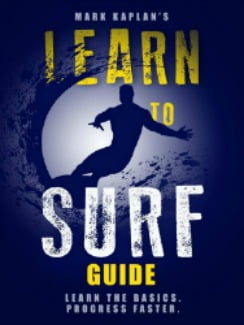How to Surf the Short Board
After learning the fundamentals, intermediates can learn how to surf the short board. Surfing is a slow progressing learning process because it is more physically demanding and technical than people realize.
What they also don’t realize as the 800 pound gorilla in the room is that it takes a lot of courage to surf real waves and then surf bigger waves. Even pros have said they were afraid at every step above 6′ height. Waves get faster and heavier as they grow.
What Short Board Surfers Have Learned
Surfing is very humbling for most beginners. Very few are up and riding on first few rides. Those who are often find themselves riding bigger foam waves and real waves in the first lesson. This is rare.
Most beginners have to learn how to paddle, how to catch foam waves, how to pop up into the correct posture, and how to ride to the beach over several sessions. Lessons help beginners with the right practices and prevent formation of bad habits that stall progress.
Once beginners paddle out to bigger foam waves, they can start with some smaller real waves. These sessions should be continued on a high volume soft top. The soft tops are easier to paddle, easier to catch waves, and easier to ride. You can ride 7′ waves with a soft top and learn most of the maneuvers, so there is no reason to rush to smaller boards.
How to Progress to Shorter Boards
Once the beginner has progressed to intermediate by riding real waves and executing all the techniques including the bottom turn and the cut back, he can start moving to a hard board that is shorter. The best first step is the 7’6″ fun board that is 21+ inches wide and 2 3/4 inches thick.
At this point, the intermediate can learn an important technique for the short boarder called accelerating in the pocket. The short board needs to advance faster than the falling lip in the pocket. To do this, the surfer moves the nose of the board up and down the face with his front foot.
Speed is the secret to performing maneuvers and tricks. Usually accelerating three times sets the surfer up to bottom turn up the face of the wave and then practice ripping the lip by performing a cut back at the top.
When surfers have become comfortable with the techniques, the shorter board is more maneuverable. But surfers should not be in a hurry. They are harder to paddle, more difficult for wave catching, and more difficult to ride. No sense killing all the fun and bringing on the frustration.
The surfer should move shorter only 6 inches at a time trying to maintain the width and thickness. Carrying the short board is cool, but if you miss waves or fall, the line up will not let you catch waves as they see you are in over your depth.
Learn More
For Oceanside Surf Lessons, see the Home Page
See the Post Surf Lessons Begin with Foam Waves
See the Post What You Learn in a 2 Hour Lesson
See the Post How to Progress in Surfing
See My Dry Land and In Water Demo video
See How to Catch a Green/Real Wave video
i have lowered my book and course prices for the lock down.
My New Surfing Course in an E-Book plus Demo Video
Get the 18 Chapter, 7,500 word Course that can prepare you for a lesson or give you the fundamentals if you are going to try it on your own. 10 years of teaching 350 students a year has given me the insights on the most precise measures you must follow for success. This course is what I teach on the dry land and in water instruction. The Course includes a 15 minute video on my dry land and in water demonstration. Only $4.95
Buy the E-book for $2.99. Learn to Surf (Different cover but same book)
Buy the Paperback on Amazon $6.95
Get Learn to Surf Course in 29 minute audio. Great prep for a lesson, reviewing after a lesson, learning on your own, refreshing after not having surfed for a while. See Table of Contents. Only $7.95

80 page Learn to Surf Book
![Surf Instructions Beginner to Advanced: Learn to Ride Waves by [Kaplan, Mark]](https://images-na.ssl-images-amazon.com/images/I/51HswFtoBQL.jpg)
Buy my E-book on Amazon Kindle for $2.99. 80 pages of beginner to advanced instructions to help you before the first lesson to learning expert techniques and tricks.
I also have books on Creating Your Own Happiness on a site called Happiness and Work Life Balance